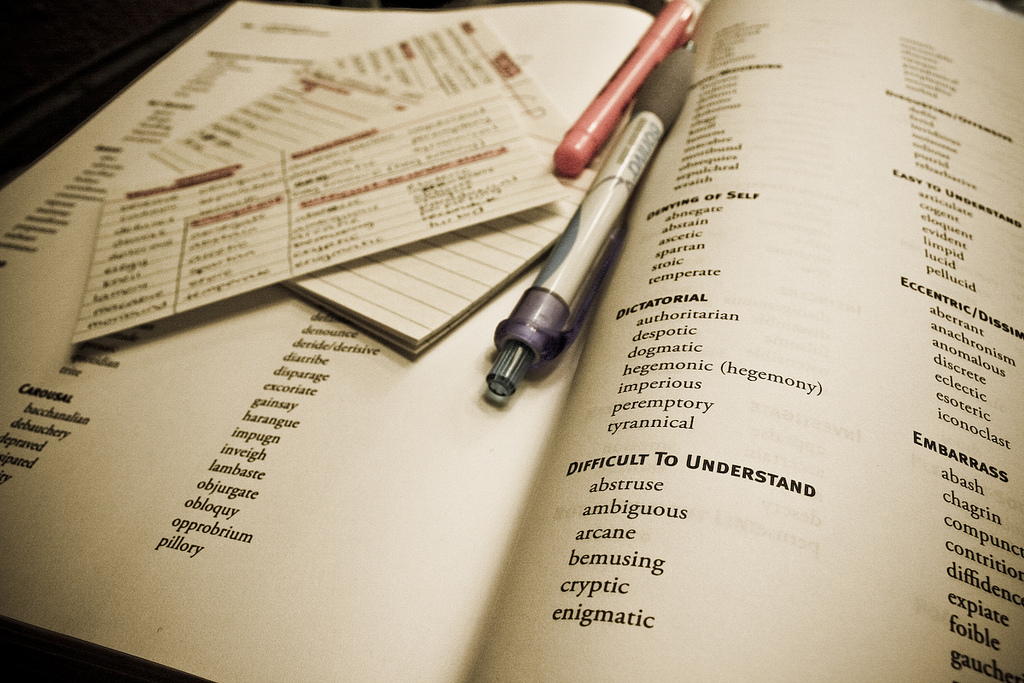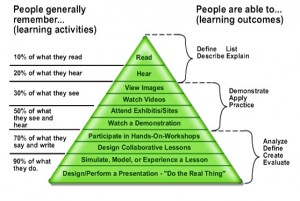7 Ways to Memorize a Language and Still Understand It Posted by meaghan on Oct 8, 2014 in Archived Posts
We published a SlideShare earlier this month discussing “8 Mistakes that Haunt Language Learners”. One of these mistakes is worth a deeper look—the concept of memorizing what needs to be understood. It’s a big problem for anyone who wants to learn a language quickly, but more importantly sustain it over time and use it fluidly.
So what, exactly, is the problem with memorizing versus understanding? When it comes to learning a language, there’s quite a bit of memorization to be done. The problem arises when learners try to memorize too much. Mindless drilling only helps us gather information in the short-term—like cramming exhaustively the day before a test, only to forget everything immediately after we put our pencil down.
Learning a language presents a similar struggle. You can memorize hundreds of words, but that won’t help you form logical sentences, understand slang and expressions, or apply grammar rules. So, what can you do to ensure that you’re actually understanding what you’re learning?
Memorize what needs to be memorized. Some pieces of a language can and should be committed to memory through good ole’ repetition. Build up your vocabulary using spaced repetition—a learning technique that involves spacing out review of learned material over time to improve retention. If you need some help, Transparent Language Online employs a spaced repetition algorithm, and will present you with lesser-known material for review more frequently than mastered material.
Look for patterns. While you’re acquiring vocabulary, be on the lookout for patterns, or disruptions to patterns. For example, you might notice that the adjective “bleu” (blue) in French is spelled “bleue”. There is a reason for this: French adjectives agree with the gender of the modified noun. Understanding this concept will help you apply this rule across the board to every adjective, preventing you from having to memorize each and every instance where you need to append an extra -e. Look for these types of patterns, and seek out explanations.
Use mnemonics and tricks. My high school French teacher used the acronym “BAGS” to help us remember which kinds of adjectives come before a noun (whereas the typical adjective would come after). Ten years later, I can still tell you that adjectives describing beauty, age, goodness, or size come before the noun. Apparently, the acronym worked. Using mnemonic devices, acronyms, songs, and other “tricks” are still a form of memorizing, but they’re not mindless. Reading idly about adjective placement over and over won’t help you remember which ones go where. Coming up with a simple acronym like BAGS forces you to really think about what you’re reading and actively design a way to remember it.
Engage your senses. According to Edgar Dale’s Cone of Experience, we retain about 10% of what we read and 20% of what we hear, but up to 90% of what we say and do. The more actively involved you are with the material you’re learning, the more likely you are to retain it. When you’re studying, go beyond textbooks. Look for resources that involve audio, images, and interactivity. Read or speak out loud—with a foreign language, the benefits are twofold: speaking the words out loud will help you remember them and give you a chance to practice pronunciation. Make gestures or facial expressions to act out what you’re learning—getting physical will create a mind-body connection that reinforces the words and phrases you’re learning.
Explain the concept to someone else. Remember, we can recall up to 90% of what we do, and what better way to put a language to use than by spreading it around! One of the most powerful ways to check your comprehension is to explain a concept to someone else. Discussing a grammar rule or pattern out loud will help you remember it, and having a friend or family member there to listen will give you a memory to associate with that concept. It will also help you identify concepts you don’t know quite as well—if you can’t easily explain it to someone else, chances are you don’t understand it fully yourself.
Be interested. One of the reasons so many students face the cram-and-forget dilemma mentioned above is simply that they’re uninterested in the material. Edward Bolles, author of “Remembering and Forgetting,” puts it best: “We remember what we understand; we understand only what we pay attention to; we pay attention to what we want.” So, don’t force yourself to study when you’re tired, distracted, or unmotivated—you won’t remember much of it anyway. If you really want to remember what you’re cramming in to your brain, you need to be present, interested, and excited to learn it.
Review often. This may be the advice you were dreading all along, but there’s really no way around this one—you need to review what you’ve learned. Plain and simple. Fortunately, we’ve done some leg work to make language review a lot easier for you. Transparent Language Online includes a language retention system, which we call “Learned Words and Phrases”.Our program automatically keeps track of learned content that you haven’t seen in a while, and brings it back into later sessions. If you demonstrate that you still know it, it is tucked away for a future check. If you struggle with it, Learned Words and Phrases refreshes it and notes that for future checks.
So, there you have it. Learning a language takes a lot of work, but that work doesn’t need to involve hours and hours of mindless memorization. Seek out resources that you find fun, resources that engage you in listening, reading, writing, and speaking the language, and resources that make it easy for you to review and retain what you’ve learned. Want more advice on this topic? Download our FREE eBook:

Build vocabulary, practice pronunciation, and more with Transparent Language Online. Available anytime, anywhere, on any device.







Comments:
Rita:
Your advice to “be interested” seems obvious, but is something that is often lacking in my high school language students. Although I enjoyed reading your advice, I had a hard time believing that we remember more of what we hear than of what we read, as the opposite is generally true. A little sleuthing turned up an article that debunks the graph you borrowed. You made many good points about language learning–I hope you will reconsider the use of the bogus statistics.
http://www.willatworklearning.com/2006/05/people_remember.html
meaghan:
@Rita Hi Rita! I appreciate you taking the time to look in to it! I can assure you that the graph is not “bogus” – it’s very widely known in the teaching world (which is not to say that it’s 100% true, of course, but it’s not just something I grabbed from a random Google search). Dale’s Cone of Experience is based on several theories related to curriculum design and the process of learning. Dale’s research took place in the 1960s, so we may know more now that debunks some of his thinking, and even Dale himself never actually used any specific numbers or percentages on the cone and warned others not to take it too seriously. But his idea in general is still widely accepted by fans of experiential learning, that the more ways students can engage with material, the more they will remember.
Chris Stolz:
The use of mnemonics, pattern identification, etc, has been discredited in the research. If you memorise BAGS for adjectives, or DR AND MRS VANDERTRAMP for the être and avoir p-c verbs in French, great…but this is conscious knowledge, and there is very limited transfer of conscious knowledge into long-term functioning language memory. Ask any high-school teacher: you can worksheet and grammar lecture your kids to death and they will STILL say “j’ai allé.”
A much better strategy is to read and listen to a lot of compelling comprehensible input.
Regarding memorising stuff: research also discredits this. We learn best by getting MEANINGFUL input, not by memorising lists…a process that comes most easily via reading.
Michael Schmitz:
@Chris Stolz The “truth” often lies in the middle. It absolutely makes sense to binge some vocab for a few minutes before using it e.g. by reading an article or passage of a book you like. Of course the vocab you learn must be taken from this text. Just reading a text and looking up words will only frustrate you or in case of simplified texts for language learning purposes bore you quickly. Science by the way has found that memorization of vocabulary with a mnemonic device was up to 60% more effective.
I completely agree that meaningful information is learned much quicker, but unfortunately many topics in a new language simply do not mean anything nor do they make any (logical) sense to us until later. And even when there’s a meaning or logic to something like the German irregular verbs it often at times simply is far too complex to be used by a normal language learner. That’s when mnemonics do a great job.
That “cone” graph though is at best an incentive to think about one’s learning or teaching habits, but scientific it never was. The fact that a lot of people in many learning-related fields recite that graph in various forms doesn’t make it any more true. Thanks for the link though, I didn’t know that one before.
Sean L. Young:
If people were to be taught how to LEARN a language, then memorization would not be a problem. All that is needed is learning how to get to a proper mindset when it comes to approaching a language, and finding a way to be taught properly how to learn.
Maddie dickinson:
I do the cram and forget dilemma. I could review more
João:
Meaghan, Good post!
The tips are really effective.
One of the techniques that more use is exactly to teach to someone else. Even better if the content is difficult because I have to arrange ways to teach the other person.
Bruno Silva Cordeiro:
Well placed, I usually teach my kids this every day, but Sophia still has difficulties. Thank you so much for sharing this pot!
Daniely Lima:
Very important for everything in practice, my best way to learn is to explain the content to myself, so my performance increases double but your tips are also excellent, thank you!
Ahmad ishtiyaq:
Hi, I am a native speaker of Hindi language and it’s my mother tongue. But I’ve been facing some of the issues in my mother language even despite learning it. So the issue is regarding memorization, do we actually memorize native tongue while we were child or any other trick was there we used to get the language understanding and now when I speak so I’ve starter memorizing the sentences and words. For instance- I have to go so what I do is, have comes after I and to comes after have and so on and I’ve applied it on every sentence. It really gets tougher to do it. Please answer it and give any well solution for this. Thanks